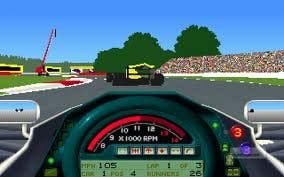Retrospective: Formula One Grand Prix
Grand Prix legend.
Games can make dreams a reality, whether your own particular fantasy is saving the universe, rescuing the princess or sticking a chainsaw up an overgrown lizard's arse. Throughout my pre-teen twilight years in the early nineties, my own dream was simple enough: to become a grand prix driver, or at the very least to drive cars fast for a living.
Thanks to a dedicated father and the backing of a few local businesses, I came closer than most to realizing this. The pair of us spent our weekends travelling across the country to race 100cc karts, pounding the training grounds of future greats in what would prove a particularly fertile time for the sport.
In the few short years of my racing career I witnessed a thirteen-year-old Jenson Button parallel park a Renault Clio in the paddock, once kept Lewis Hamilton at bay for all of two laps and spent one autumn night hiding behind the bins at the back of a Banbury pub having purposefully ruined future Indy 500 winner Dan Wheldon's game of skittles.
Though I was surrounded by the future generation's stars, I was hardly shaping up to be one myself - truth was, I was mediocre. We were under-resourced - our base of operations was a sickly Sierra Estate in which we'd also sleep at nights - and I was undisciplined, slouching around the track like the slovenly teen that I was.
On the weekends I wasn't away racing, Geoff Crammond's Formula One Grand Prix offered a welcome retreat; here, I wasn't struggling in the middle of the pack but was instead leading the field home in a red and white McLaren, tasting glories unimaginable in my own exploits. As a form of escapism, it was unparalleled.

Before 1992's Formula One Grand Prix, racing games often offered no real pretense of simulation. Games like Accolade's Grand Prix Circuit (designed, fans of throwaway trivia may be interested to know, by a young Don Mattrick) were fun but crass flicker book affairs, only a couple of steps removed from the LED handhelds that would rattle around as free gifts in cereal boxes.
Papyrus' Indianapolis 500: The Simulation was, as its title helpfully implies, a little closer to the truth of an afternoon spent in the cockpit. Polygons were swapped in for sprites, but most importantly the feel of a open wheel car had been captured through an appropriation of real world physics. Its scope was slim - the titular speedway was the only track available - but it pointed towards exciting new possibilities for the genre.
Three years further down the line and these possibilities were realised in staggeringly comprehensive fashion. Formula One Grand Prix took the ambition of Indianapolis 500 and spun it out over an entire season of racing, offering up 16 tracks modeled with an authenticity that was at the time unmatched.
Claiming that what you played came close to what you saw on a Sunday would be a stretch - polygons were sparse, and the game had one optional texture reserved for the track surface. Turning this feature on was enough to make my 386 whine like a Ferrari V12 - but everything was in its right place. Monaco's tunnel, the stomach-turning incline of Eau Rouge and the stand at Silverstone's Woodcote in which I'd watched my first ever motor race were all present and correct.

